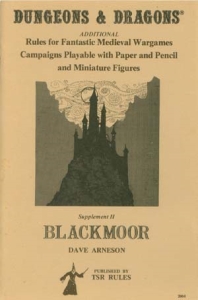In my A Game Per Year project, my goal has been to read one roleplaying game corebook for every year they’ve been published. However, I soon started to feel that it was hard to decipher how the games were really meant to be played. For this reason, I decided to start a parallel project, An Adventure Per Year, to read one roleplaying adventure for each year they’ve been published.

After Dungeons & Dragons was originally published, it was supplemented by two publications named after the home campaigns of the game’s creators. First came Greyhawk, by Gary Gygax, and then Blackmoor, by Dave Arneson.
Both are grab-bags of extra material meant to shore up the initial release of D&D. They’re also interesting because at this stage, D&D hadn’t quite found it’s voice yet, so there are interesting deviations from the shape the game later settled into. Of the two supplements, Blackmoor holds the distinction of having the very first adventure published for D&D, The Temple of the Frog.
In addition to the adventure, the book also has other material such as rules for aquatic action and a bizarre system for adjusting combat based on the relative heights and weapon reaches of the participants.
Since my goal is to learn more about roleplaying games, reading The Temple of the Frog is an unfortunate experience. I found reading the original D&D baffling, and the same goes for this. I’m not sure I understand how this material is meant to be used in an actual game, and the booklet certainly doesn’t explain it to me.
However, for being the very first example of D&D adventure design, The Temple of the Frog is certainly memorable!
It features:
- A cult devoted to replacing humanity with evolved frog creatures.
- A settlement, a temple and the dungeons under the temple.
- The temple (shaped like a titanic frog) is capable of jumping into another dimension. When this happens, an illusion makes it look as if it transformed into a frog and jumped.
- The cult is ruled by a man from another dimension who reports to controllers on a satellite orbiting above. Naturally he wears scifi battle armor and has a magic super sword.
- The cult funds its activities by using technological machines to manufacture trinkets to sell to the gullible inhabitants of this fantasy world.
- The temple’s doors and servants are controlled by a complex system of magic rings, essentially access cards.
The design is pure sandbox, with some enemies so powerful it’s hard to imagine any D&D group able to defeat them. Treasures range from the sensible to the ludicrous and the dungeon seems one of the least dangerous areas.
If I wanted to make a game out of this, I’d encourage the characters to sneak through the settlement and the temple into the dungeons to steal the easier treasure there. Or maybe come up with a more complex plot where the characters were lured in by the promises of the frog cult, only to discover the amphibian terrors within.
But that’s just me guessing. I don’t really have a clear idea of how this was played when it was originally published. It feels like it requires a GM with some experience in running the game and players who know what they’re doing.
2 thoughts on “An Adventure Per Year: Blackmoor (1975)”
Comments are closed.